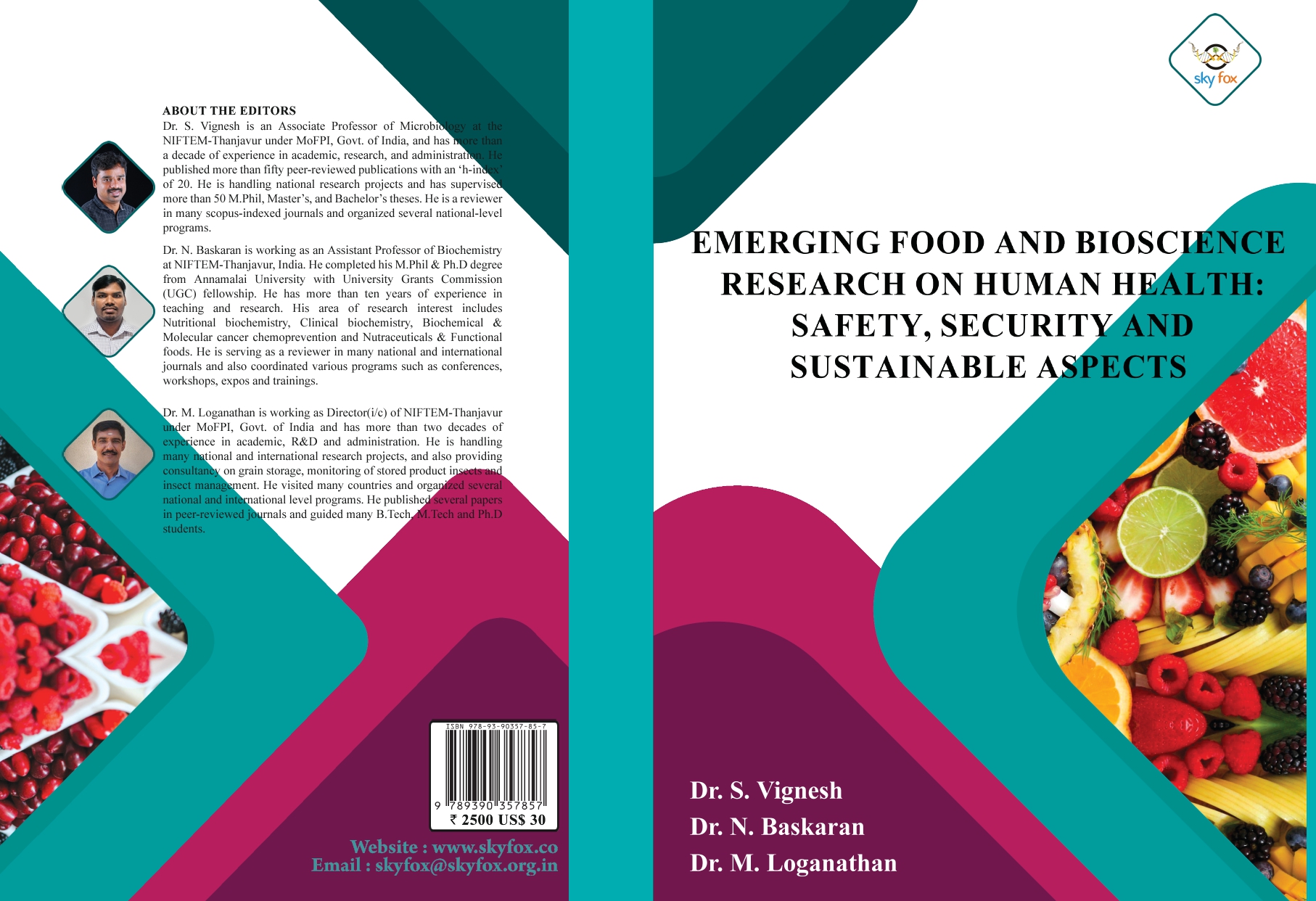A Review on Valorisation of Food Scraps and Derivatives
Chapter 6
Keywords:
Composting, food waste, gasification, landfilling, pyrolysis and valorizationAbstract
Agricultural food waste such as fruit and vegetable scraps are a significant resource for farmers who can use these wastes to grow new plant. The valorization process involves using these agricultural food waste to produce animal feed and then using the resulting animal feed to produce meat or milk. Currently, most of the agricultural food waste is used in the form of methane gas, which is a potent greenhouse gas that cause global warming. The value-added products which are fine chemicals, nutraceuticals, antioxidants, bio-actives, biopolymers and many more are used to increase the value of a product. They help to reduce the cost of production and insure a high profit margin for companies. The average American throws away nearly two pounds of food per which add up to $2,275 worth of food that is wasted every year. It’s estimated that households in India waste 50 kilograms of food per person year or 68,760,163 tonnes a year. It is also estimated that the average Indian household throws away over $1,200 worth of food each year. There are several valorization methods which are sustainable and profitable to manage. The most common methods of valorization are pyrolysis, composting, landfilling, and gasification.
References
A.V. Bridgwater (2003). Renewable fuels and chemicals by thermal processing of biomass. Chemical Engineering Journal. 91, 87–102. https://doi.org/10.1016/S1385-8947(02)00142-0
A.V. Bridgwater (2012). Review of fast pyrolysis of biomass and product upgrading. Biomass and bioenergy. 38, 68 – 94. https://doi.org/10.1016/j.biombioe.2011.01.048
Aisha Al-Rumaihi, Gordon McKay, Hamish R. Mackey and Tareq Al-Ansari (2020). Environmental Impact Assessment of Food Waste Management Using Two Composting Techniques. Sustainability. https://doi.org/10.3390/su12041595
Ayhan Demirbas & Gönenç Arin (2010). An Overview of Biomass Pyrolysis. Energy Sources. 24:5, 471-482. https://doi.org/10.1080/00908310252889979
Bárbara Socas-Rodríguez, Gerardo Álvarez-Rivera, Alberto Valdés, Elena Ibáñez, Alejandro Cifuentes (2021). Food by-products and food wastes: are they safe enough for their valorization? Trends in Food Science & Technology. https://doi.org/10.1016/j.tifs.2021.05.002
Barbora Grycová, Ivan Koutník, Adrian Pryszcz (2016). Pyrolysis process for the treatment of food waste. Bioresource Technology. 218, 1203-1207. http://dx.doi.org/10.1016/j.biortech.2016.07.064
Business Today March 08, 2021, 6:48 PM IST. https://www.businesstoday.in. (Accessed on 25th December 2022). Source: Food Waste Index Report 2021.
Daniel Trujillo, Xavier Font, Antoni Sanchez (2006). Use of Fenton reaction for the treatment of leachate from composting of different waste. Journal of Hazardous Materials B138 201–204. https://doi.org/10.1016/j.jhazmat.2006.05.053
Dinesh Mohan, Charles U. Pittman, Jr. and Philip H. Steele (2006). Pyrolysis of Wood/Biomass for Bio-oil: A Critical Review. Energy & Fuels. 20, 848-889. https://doi.org/10.1021/ef0502397
Elvis Osamudiamhen Ebikade, Sunitha Sadula, Yagya Gupta and Dionisios G. Vlachos (2016). A review of thermal and thermocatalytic valorization of food waste. Green Chemistry 2021, 23, 2806. : https://doi.org/10.1039/d1gc00536g
Elvis Osamudiamhen Ebikade, Sunitha Sadula, Yagya Gupta, and Dionisios G. Vlachos (2021). A review of thermal and thermocatalytic valorization of food waste. Green Chemistry. https://doi.org/10.1039/D1GC00536G
Francesca Girotto, Luca Alibardi, Raffaello Cossu (2015). Food waste generation and industrial uses: A review. Waste Management. 45, 32-41. http://dx.doi.org/10.1016/j.wasman.2015.06.008
India Today. https://www.inidatoday.in. (Accessed on 26th December 2022). Source: PIB, ICAR/CIPHET
Jenny Gustavsson, Christel Cederberg & Ulf Sonesson SIK – The Swedish Institute for Food and Biotechnology (2011). Global Food Losses and Food Waste. Save Food Congress, Düsseldorf 16 May 2011.
Manoj Tripathi, J.N. Sahu, P. Ganesan (2016). Effect of process parameters on production of biochar from biomass waste through pyrolysis: A review. Renewable and Sustainable Energy Reviews. Volume 55, 467–481. https://doi.org/10.1016/j.rser.2015.10.122
Michael Blakeney (2019). Food loss and food waste (chapter 11). Edward Elgar Publishing. https://doi.org/10.4337/9781788975391
Rai Naveed Arshad, Zulkurnain Abdul-Malek, Ume Roobab, Muhammad Imran Qureshi, Nohman Khan, Mohammad Hafizi Ahmad, Zhi-Wei Li, Rana Muhammad Aadil (2021). Effective valorization of food wastes and by-products through pulsed electric field: A systematic review. Journal of Food Process Engineering. https://doi.org/10.1111/jfpe.13629
Samar Elkhalifa, Tareq Al-Ansari, Hamish R. Mackey, Gordon McKay (2019). Food waste to bio-chars through pyrolysis: A review. Resources, Conservation & Recycling. 144, 310 – 320. https://doi.org/10.1016/j.resconrec.2019.01.024
Semih Otles, Canan Kartal (2018). Food waste valorization. sustainable Food Systems from Agriculture to Industry. 371-399.
Shane Morrin, Paola Lettieri, Chris Chapman, Luca Mazzei (2012). Two stage fluid bed-plasma gasification process for solid waste valorisation: Technical review and preliminary thermodynamic modelling of sulphur emissions. Waste Management. 32, 676–684. https://doi.org/10.1016/j.wasman.2011.08.020
Simone Manfredi, Davide Tonini, Thomas H. Christensen, Heijo Scharff (2009). Landfilling of waste: accounting of greenhouse gases and global warming contributions. Waste Management & Research. 27: 825. https://doi.org/10.1177/0734242X09348529
Soosan Kim, Younghyun Lee, Kun-Yi Andrew Lin, Eunmi Hong, Eilhann E. Kwon, Jechan Lee (2020). The valorization of food waste via pyrolysis. Journal of Cleaner Production, 259, 120816. https://doi.org/10.1016/j.jclepro.2020.120816
Zhentong Li, Hongwei Lu, Lixia Ren, Li He (2013). Experimental and modeling approaches for food waste composting: A review. 93, 1247 – 1257. https://doi.org/10.1016/j.chemosphere.2013.06.064 .
Downloads
Published
Issue
Section
Categories
License
Copyright (c) 2023 © 2023 The Author(s), under exclusive license to Skyfox Publishing Group

This work is licensed under a Creative Commons Attribution 4.0 International License.
Our journals offer different licence options, please see the Instructions to Authors page of the relevant journal for more information.
Books and book chapters
When publishing a book, or a chapter in a book, the terms of licensing and copyright will typically be included in a contract which you would have to agree with a publisher and which will specify the usage rights, the format(s) and length of time applied to the work.
Book contracts vary from publisher to publisher, and can in some cases be complicated. If you are required to sign a contract with a publisher in order to publish your work you need to ensure that the contract covers your rights and that it takes into account the obligation you have to your employer and/or the funder of your research.
If you want to publish a thesis or dissertation it is recommended that you contact your institution or department to make sure that you follow their policy for such publications.
Kindly Check the concern book title for How To Cite. Plese ignore if any citation format provided in Book Section





